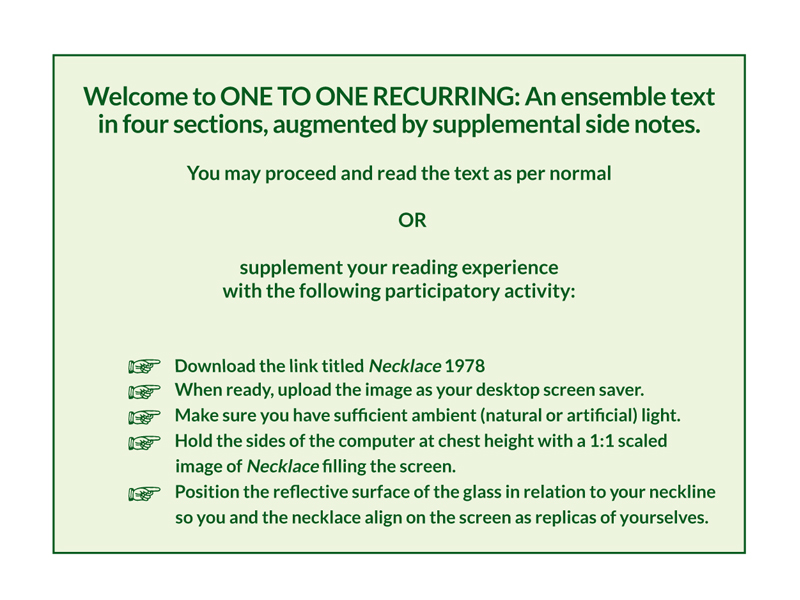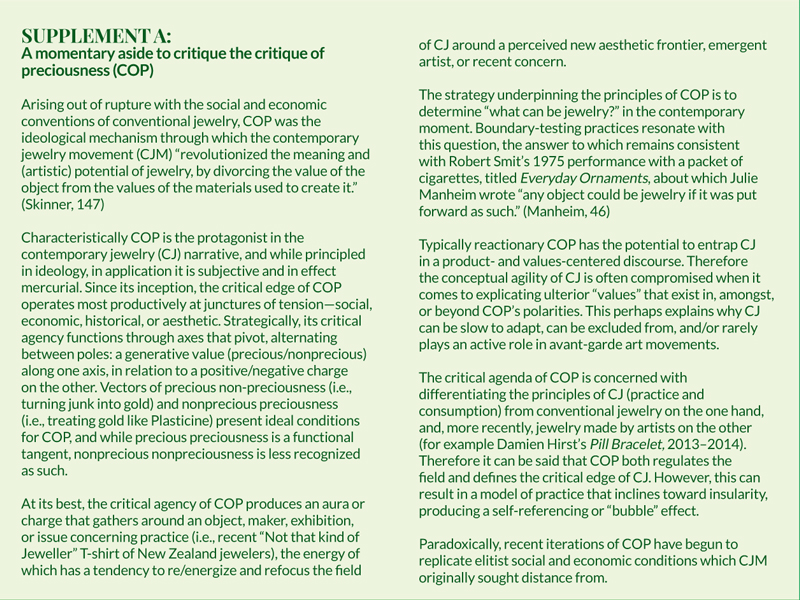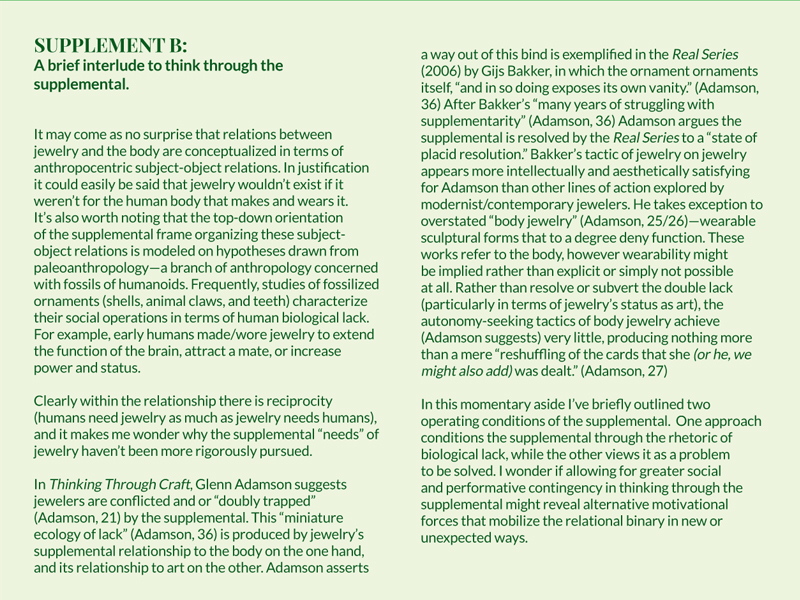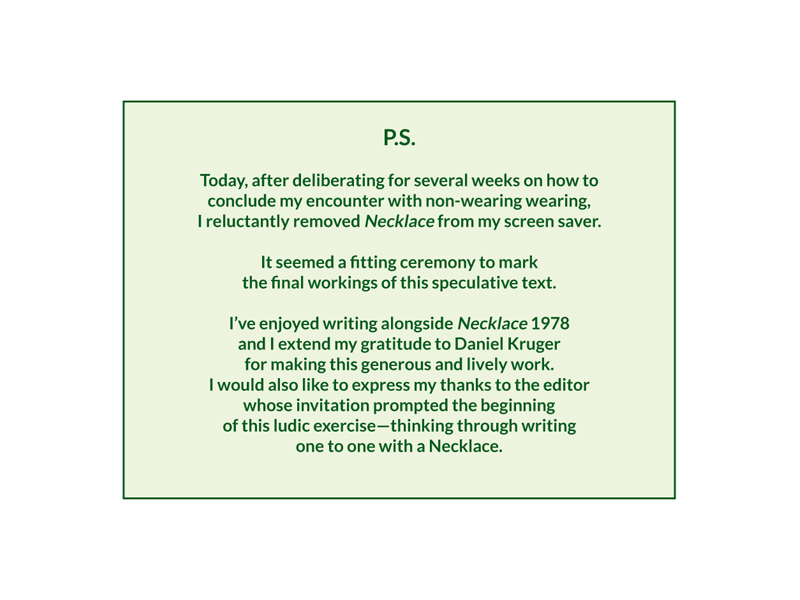
A note on bibliographical references: The typographical complexity of this publication requires that we bend some of the rules of AJF’s style guide. Bibliographical references are given in the body of text as “(Author, page)” rather than in footnotes.
—Benjamin Lignel, editor
INTRODUCTION
This ensemble text is staged around a speculative relational event, a simulated co-occurrence between two almost, but not quite, things. The staging of this event takes place within an abstracted social space of wearing, alongside of which subtle references to weariness and worn out are entertained.
The strangeness of this encounter was brought about by an invitation to write on (decode and appraise) a piece of jewelry made in Germany at a pivotal moment in the then-emerging contemporary jewelry movement (1950s–1990s). On first assessment, the task seemed doable; there were obvious similarities in the artist’s use of found object and earlier work of my own.
However, after several attempts to author a response, it became apparent that in order to bring the object to light, or life, I would need to reorient gaze and intention. Rather than look directly at Necklace 1978 and comment on it (authoritative voice), I considered what it might mean to “look among” (Elkins, 39) the object, to correspond with Necklace 1978 as both a participant and an observer. The duality of these roles, the relationship between them, and the relationship they facilitated with the work opened the text to dynamic forms of encounter and exchange. What emerged was a process of thinking through writing along with a piece of jewelry.
In writing through an action of doubling (writing and wearing as performative event), I am attempting to understand anew the relational, material, and affective potential of “contemporary” jewelry in the context of the current moment.
The form and content of the following text threads together a series of narrative devices, the style of which evoke supplemental characteristics that may be read as ornamental as well as structural. Graphic emphasis, flamboyant prose, and document layout are direct outcomes of this strategy.
SECTION A

LINK: Necklace 1978
SECTION B: PREFACE
I began writing this text in response to an invitation: “If you have the time … if you are interested … I’d like to ask you to write 500 words on this work by Daniel Kruger for our One on One series.” Attached to the email was a digital image of Necklace 1978 arranged slightly splayed, on an off-white background.
With a quick online search I familiarize myself; Necklace 1978 is an early work of Kruger’s made while studying with Hermann Jünger at the Munich Academy. It’s a radical (for the time) pairing of rusty heeltaps with scuffed colorful plastic forks gathered together with silver tubes, jump rings, and fixtures. The work seemed to be resonant with Jünger’s nascent philosophy of making, “unifying thought and action” (llse-Neuman, online)—or what we now refer to as thinking through making. At the time, the emergent “maker as artist” posed a significant break from traditional master craftsman training (according to the European journeyman model). This alternate approach foregrounded artistic expression, the use of nontraditional materials and techniques, and was informed by democratic ideals. Such ideals were instrumental in the developing the Critique of Preciousness (see supplement A), the principles of which were fundamental to the forming of a contemporary jewelry movement. The effects of these divergent factors were gathering momentum around the time of Necklace 1978’s making.

Returning to the image of Necklace 1978, I was charmed by what I saw. However, the thought of writing with fresh insight on this work seemed a challenge given my geographical and historical distance from the context of its making. Could this lack of proximity be overcome, I wondered, if I found a way to form a relationship with the object/image in the here and now? Narrowing the distance between the jewelry piece and I might only be, I surmised, a matter of shifting perception.
Drawing momentum from these thoughts, a proposition arose: If the image titled Necklace 1978 is a representation of the real thing, could I figure in an experience with it as a representation/image of myself? Could we “co-occur” in a “different register of existence”? (Massumi, 4)
The proposition intrigued me. I was hooked, you could say, and like Alice (in Wonderland) I was eager to cross the threshold and experience the resonant forces of this parallel world. However, in laying the groundwork for this relational encounter, further questions arose. How and where would this different register of existence take place? How would the abstraction of ornamentation be articulated, written through the writing of the text? Should the relational equation of the text remain as commissioned—one on one, or reorient topologically in terms of one to one?
And then it occurred to me that in articulating my approach, I’d squandered the allotted 500-word limit. From this juncture, the text performs in excess of the amount requested; however, in the context of thinking through relations between things, this extravagance is pivotal to understanding the initial brief.
In thinking through the writing of this ensemble text, I have been inspired by Roland Barthes, who wrote, “the most modest piece of jewelry remains the vital element in getting dressed, because it underlines the desire for order, for composition, for intelligence.” (Barthes, online)
Please note: Following the instructions in Section A
may enrich your reading of Section C.
SECTION C
In preparation for this tête-à-tête, I load the image of Necklace 1978 by Daniel Kruger as the screensaver on my laptop. Each morning, I face into the light, holding the sides of my computer at chest height, and a 1:1 scaled image of Necklace fills my screen. Positioning the reflective surface of the glass in relation to my neckline I, or should I say “We” (Necklace and I), align on the screen as replicas of ourselves. My laptop experiment produces an unfamiliar approach to wearing; it manifests an abstract synthesis of quasi objects suspended in a state of virtual embellishment.
The compulsion I have to form a connection with Necklace is strong, and whilst paradoxical, this virtual coupling is the closest sensory action I can muster to simulate the habitual encounter, commonly referred to as “trying on.” It could be argued the physical and emotional intimacy garnered through non-wearing wearing is far from the effect of the “real” thing. However, the experience seems to reveal qualities of Necklace I might otherwise have overlooked.
As time passes, I observe my relationship to Necklace becoming less one-sided; it’s as if Necklace “has a certain force, a certain way of resisting or accepting my look and returning that look to me.” (Elkins, 70) After a few repetitions (openings and closings of the laptop), my hold over Necklace begins to loosen and an alternate thread of becoming emerges. As accomplices in an unfolding event, we become complicit in a celebration by proxy of Necklace’s making.
On one occasion, while caught up in the facsimile of our suspended selves, a conversation ensued:
“Are you ok?”
(I express my concern in regard to the softening of edges—initially due to pixilation. Shimmering every so slightly, Necklace holds steady and keeps me dangling for an answer.)
“Who do you think is supplementing whom?” I ask.
(I’m curious, in this situation, how we determine who is wearing whom? In thinking through the relational logic of jewelry, I sense my growing weariness with valuing the primacy of one form of matter over another. (See supplement B) Enacting the paradox of wearing non-wearing opens a liminal space for contemplating other relational paradigms. I wonder what “other” might be rendered in, or animated by, our analogous alliance, so I ask….
“Who or what do we become in the play of our coexistence?”
(In the paradoxical gap produced by wearing not wearing, my sense of composure is unsettled; could it be that I am becoming less human and in turn Necklace is becoming more? In forming this association, are we collaborators in a process of transformation, an event that moves closer toward, whilst paradoxically remaining distinct from, one and the same? Are Necklace and I now co-conspirators, contemporaries who are accessories, too, whilst simultaneously performing in the surplus economy of ornamentation?
It appears to me that this mode of call and response generates more questions than it manufactures answers.
Stepping aside, I put down my laptop, inhaling exhaling, I attempt to reestablish a sense of self. In this lull between what is and what might become, I fall into a mode of second-guessing, whereby I negotiate the temptation to over-determine an outcome by predicting the response. In a minor aside, addressing no one in particular, I ask:
“How successful is this play of allegorical selves—where I am (and as the reader potentially you are) almost but not quite user/consumer and Necklace is almost but not quite product/form—in reconfiguring relations between human and nonhuman things?”
I glance sideways, looking toward Necklace, and notice she appears somewhat flat. Is she, I wonder, no longer entertained by this boudoir encounter? I am reminded of the words social anthropologist Tim Ingold wrote: “in the underbelly of things, materials may lie low but are never entirely subdued.”(Ingold 2007, 10) Returning to the screen, I register a subtle form of unrest, not knowing why I am compelled to move location. My hunch is the experimental encounter that Necklace would prefer to lead is more street party than private chamber.

Over a couple of weeks, Necklace and I extend our opportunities for gestural wearing. Now good friends, we hang out; cafes, universities, and parks are some of the public spaces we co-occur. In these communal settings, an alternate chain of events impresses upon the immersive terms of our engagement. The interdependency of our one to one arrangement begins to deploy, opening out along parallel encounters with other animate and inanimate bodies. The optical effects of these encounters are intensified through a string of additional sensory happenings, rhythmic gestures that are both sonic and tactile: footstep tapping; cutlery click-clacking; chair scraping; baby crying; door slamming; dog barking; rain pouring; voices laughing. In this dynamic social field, an alternate conversational thread arises, the sociability of which invites the sharing of “almost jewelry” situations of others. Personal accounts of the almost made, almost bought, almost given, almost lost, almost worn, almost forgotten, and almost married are shared and celebrated in their retelling.
Forming an encounter with Necklace in an abstracted version of the here and now invites reflection on the cyclical nature of before and after. I’m curious to know what processes and entities wrought the wear and tear of the plastic forks and metal heeltaps. Who were the dancer, the walker, the server, the eater, the observer, and the collector?
In thinking through the to and fro of these relations, I am drawn once again to the writing of Tim Ingold:
“The forms of things are not imposed from without upon an inert substrate of matter, but are continually generated and dissolved within the fluxes of materials across the interface between substances and the medium that surrounds them. Thus things are active not because they are imbued with agency but because of ways in which they are caught up in these currents of the lifeworld.” (Ingold 2007, 1)
By attending to the actions and activities of ulterior forces (the many persons and sensory occurrences that have congregated within and without this wearing non-wearing event), I’ve cleaved a small opening (large enough to dip a finger) into the entangled “meshwork” (Ingold 2013, 132) of supplementing relations. In doing so, it has been possible to catch a glimpse of (and poke around in) the “currents of the lifeworld” (Ingold 2007, 1) circulating within and without the abstract alloy of Necklace’s making. To a degree, this event appears to have subverted the normative logic that the subjective object (Necklace), as a material entity, was resolved in 1978. In this situation, the autonomous jewelry object (a much-desired outcome of contemporary jewelry) appears less stable. Or could it be that when afforded the opportunity, the supplemental has revealed its capacity to perform in a more mobile and empathic manner?
Reflecting on the supplemental (its ornamental and structural role) and the economies of value at play within the critique of preciousness has left me wondering if the critical impetus that informed the heady days of the contemporary jewelry movement are appropriate today. Might there be a looming imperative to reevaluate how effective the field of contemporary jewelry is in engaging social, political, and environmental conditions of this time? If the field of contemporary jewelry wants to remain relevant to the contemporary or be recognized as a critical art form, how else can modes of its existence (material, spatial, temporal) be revitalized?
I doubt I’m alone in asking these questions, and I don’t imagine in the 21st century there is a single answer, or a unified way forward.
However, I am curious to know what others think. So if you have the time … if you are interested … I would like you to write a response—500 words or less!

INDEX IMAGE: Daniel Kruger, Necklace, 1978, silver, plastic chip forks, various found objects, length 540 mm, height of pendants: 90 mm, on permanent loan to the Danner Stiftung, photo: Peer van der Kruis, modified by Roseanne Bartley
BIBLIOGRAPHY
Glenn Adamson, Thinking Through Craft (Oxford and New York: Berg Publishers, 2007).
Roland Barthes, “From Gemstones to Jewellery,” in The Language of Fashion (Oxford: Berg, 2006), first published as “Des Joyaux aux Bijoux” in Jardin des Arts, no.77 (1961): 2–14. http://www.current-obsession.com/roland-barthes-from-gemstones-to-jewellery/.
James Elkins, The Object Stares Back: On the Nature of Seeing (New York: Simon & Schuster, 1996).
Tim Ingold, Making: Anthropology, Archaeology, Art and Architecture (London and New York: Routledge, 2013).
Tim Ingold, “Materials Against Materiality,” in Archaeological Dialogues 14, no. 1 (2007): 1–16. DOI: http://dx.doi.org/10.1017/S1380203807002 127.
Max Koss, Momentous Ornament: Conceptions of Ornament in the Writings of Wolfflin, Riegl and Warburg, undated, accessed via https://www.academia.edu/996191/Momentous_Ornament.
Wilhelm Lindemann, ed., Thinking Jewellery: On the Way towards a Theory of Jewellery (Stuttgart: Arnoldsche Art Publishers, 2011).
Julia Manheim, Sustainable Jewellery (London: A&C Black, 2009).
Brian Massumi, What Animals Teach Us about Politics (Durham, NC and London: Duke University Press, 2014).
Ursula llse Neuman, “The Jewelry of Hermann Junger,” accessed via http://www.ganoksin.com/borisat/nenam/hermann-junger.htm, first published as “Hermann Junger: The Jeweled Meadow” in Metalsmith 22, no. 1 (Winter 2002).
Damian Skinner, ed., Contemporary Jewellery in Perspective (New York: Sterling, 2013).




